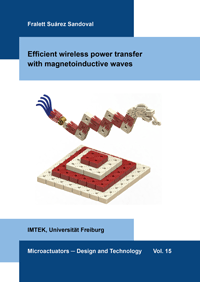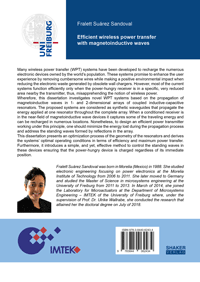
Shop : Details
Shop
Details
49,80 €ISBN 978-3-8440-6243-4Softcover206 pages71 figures405 g24 x 17 cmEnglishThesis
October 2018
Fralett Suárez Sandoval
Efficient wireless power transfer with magnetoinductive waves
Many wireless power transfer (WPT) systems have been developed to recharge the numerous electronic devices owned by the world's population. These systems promise to enhance the user experience by removing cumbersome wires while making a positive environmental impact when reducing the electronic waste generated by obsolete wall chargers. However, most of the current systems function efficiently only when the power-hungry receiver is in a specific, very reduced area nearby the transmitter, thus, misapprehending the notion of wireless power.
Wherefore, this dissertation investigates novel WPT systems based on the propagation of magnetoinductive waves in 1- and 2-dimensional arrays of coupled inductive-capacitive resonators. The proposed systems are considered as synthetic waveguides that propagate the energy applied at one resonator throughout the complete array. When a conditioned receiver is in the near-field of magnetoinductive wave devices it captures some of the traveling energy and can be recharged in numerous locations. Nonetheless, to design an efficient power transmitter working under this principle, one should minimize the energy lost during the propagation process and address the standing waves formed by reflections in the array.
This dissertation presents an optimization process of the geometry of the resonators and derives the systems' optimal operating conditions in terms of efficiency and maximum power transfer. Furthermore, it introduces a simple, and yet, effective method to control the standing waves in these devices ensuring that the power-hungry device is charged regardless of its immediate position.
Wherefore, this dissertation investigates novel WPT systems based on the propagation of magnetoinductive waves in 1- and 2-dimensional arrays of coupled inductive-capacitive resonators. The proposed systems are considered as synthetic waveguides that propagate the energy applied at one resonator throughout the complete array. When a conditioned receiver is in the near-field of magnetoinductive wave devices it captures some of the traveling energy and can be recharged in numerous locations. Nonetheless, to design an efficient power transmitter working under this principle, one should minimize the energy lost during the propagation process and address the standing waves formed by reflections in the array.
This dissertation presents an optimization process of the geometry of the resonators and derives the systems' optimal operating conditions in terms of efficiency and maximum power transfer. Furthermore, it introduces a simple, and yet, effective method to control the standing waves in these devices ensuring that the power-hungry device is charged regardless of its immediate position.
Keywords: Wireless power transfer; resonators; magnetoinductive waves; metamaterials; magnetic resonance; double-spiral coil
Available online documents for this title
You need Adobe Reader, to view these files. Here you will find a little help and information for downloading the PDF files.
Please note that the online documents cannot be printed or edited.
Please also see further information at: Help and Information.
Please also see further information at: Help and Information.
| Document |  | Document | ||
| Type |  | |||
| Costs |  | 37,35 € | ||
| Action |  | Purchase in obligation and download the file | ||
| Document |  | Table of contents | ||
| Type |  | |||
| Costs |  | free | ||
| Action |  | Download the file | ||
User settings for registered online customers (online documents)
You can change your address details here and access documents you have already ordered.
User
Not logged in
Export of bibliographic data
Shaker Verlag GmbH
Am Langen Graben 15a
52353 Düren
Germany
Am Langen Graben 15a
52353 Düren
Germany
Mon. - Thurs. 8:00 a.m. to 4:00 p.m.
Fri. 8:00 a.m. to 3:00 p.m.
Fri. 8:00 a.m. to 3:00 p.m.
Contact us. We will be happy to help you.



